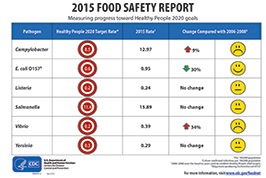FoodNet 2015 Preliminary Data
Documenting trends in foodborne illness—which illnesses are decreasing and which are increasing—is essential to the overall goal of reducing foodborne illness. Each year, FoodNet reports on the changes in the number of people in the United States sickened with foodborne infections from these pathogens that have been confirmed by laboratory tests. This “report card” also lets CDC, our partners, and policy makers know how much progress has been made in reducing foodborne illness.
This year’s report summarizes 2015 preliminary surveillance data and describes trends since 2012 for infections monitored by FoodNet—Campylobacter, Cryptosporidium, Cyclospora, Listeria, Salmonella, Shiga toxin-producing Escherichia coli (STEC) O157 and non-O157, Shigella, Vibrio, Yersinia—and hemolytic uremic syndrome (HUS).
Key Findings
- Tables %26 Figures

- In 2015, FoodNet received reports of 20,107 confirmed cases, 4,531 hospitalizations, and 77 deaths. FoodNet also received reports of 3,112 positive culture-independent diagnostic tests (CIDTs) without culture-confirmation – a rate more than double that of 2012–2014.
- Compared with 2012–2014, the incidence of Cryptosporidium and non-O157 STEC infections was higher in 2015. These increases were likely driven by increases in diagnostic testing.
- Recent changes in diagnostic practices challenge our ability to find outbreaks and monitor disease trends. Some information about the bacteria causing infections, such as subtype and antimicrobial susceptibility, can only be obtained if a CIDT‐positive specimen is also cultured. Increasing use of CIDTs affects the interpretation of public health surveillance data and our ability to monitor progress toward achieving prevention goals.
- The most frequent causes of infection were Salmonella and Campylobacter, a finding that is consistent with previous years. Although Salmonella infections overall have shown little change since 2012-2014, infection with Salmonella serotype Typhimurium has decreased 15%.
Suggested citation: Huang JY, Henao OL, Griffin PM, Vugia DJ, Cronquist AB, Hurd S, Tobin-D’Angelo M, Ryan P, Smith K, Lathrop S, Zansky S, Cieslak PR, Dunn J, Holt KG, Wolpert B, Patrick ME; Centers for Disease Control and Prevention (CDC). Infection with Pathogens Transmitted Commonly Through Food and the Effect of Increasing Use of Culture-Independent Diagnostic Tests on Surveillance — Foodborne Diseases Active Surveillance Network, 10 U.S. Sites, 2012–2015. MMWR Morb Mortal Wkly Rep. 2016 April 15:65:368-371


